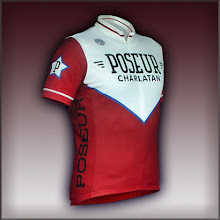But when taking pictures last weekend for Beginning Bicycle Commuting, I noticed that there was some wear showing on my older saddle. That is to say, wear other than that suffered in crashes!
Here are side-to-side photos of the older saddle and the new one for comparison. Well, above and below then...


You can see that the rails and seatpost clamp show wear. The helpful markings on the rails are completely worn off, as is some of the paint, and the seat-bag is also showing wear.
Here is a different angle so that you can see some of the damage wrought by crashes:

The trailing "wing" on the left has lost the plastic covering accent, and the right side one has had some of the silver paint worn off of it.
I have found this saddle to be quite comfortable for me. A good guide for finding stuff that works is to look to racing. They need stuff that is light, durable and can be used for hours at a time. If the components they use don't work well, they are altered or replaced. That is why they use drop handle bars, for a variety of hand positions to use on extended rides. They use seats that fit human physiology and fit your "sit bones" rather than using loads of padding, or leather saddles that have to be "broken in". It has to either enhance comfort or speed.
But as a guide, it breaks down in some areas. For example, professional racing restricts frame design, and so in many ways deprives us from possibly better designs. (Recumbent.) Retail bicycle manufacturers are generally unable to market innovative designs successfully if the design isn't "validated" in the consumers mind, generally meaning racing. But it is easy to see in other areas that racing inspired innovation has been very beneficial to the transportational cyclist. (Helmet design.)
I point this out because I have sensed that many non-racing cyclists see racing oriented gear as elitist or impractical. Some of the racers trade-offs are not of value to an urban cyclist. For instance, racers will accept a much harsher ride in trade for lower rolling resistance. But one lesson casual cyclists could benefit from racing is that tread patterns are unnecessary for street bikes! Cycling specific clothing (Lycra) is universal in racing and deserves another look by those who are rejecting it for style reasons alone.
As my saddle wear demonstrates, there is a lot friction going on, but I was completely unaware of it. I am thankful for that, and I attribute my lack of abrasions to the clothing I choose to wear.
Steve, that white patch on the top of the top-tube is a route list taped onto the frame. (Your welcome.)



ChipSeal, ChipSeal, ChipSeal, actually, my guess would have been that the patch was a list of common gear/speed combos at optimum cadence.
ReplyDeleteIf, instead, I were to ask questions, four that pop IMMEDIATELY to mind are:
Is that Specialized bag as big as it looks and does it cause problems when used in combination with a Giant bicycle?
Are those speedplay pedals and why did you choose them over the plethora of other choices?
Is that a "Bicycles Inc" water bottle and how is it that you have such a bottle when there's no "Bicycles Inc" store anywhere NEAR Ellis County?
Is it just a coincidence that I also typically use a non-insulated "Bicycles Inc" bottle, albeit in the sexy "semi-see through" version?